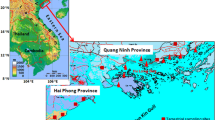Abstract
Concentrations of 137Cs and 226Ra in the diet (foodstuffs and drinking water) of adult inhabitants in the high-level natural radiation area (HLNRA) of Ramsar, Iran have been determined. The annual intake of foodstuffs was estimated on the basis of their average annual consumption. Food samples collected from local markets were analyzed by means of a gamma spectrometer. The estimated annual dietary intakes of 137Cs and 226Ra were 130Bq and 245Bq, respectively. The concentrations of natural radionuclides in food and drinking water of the residents are higher than the world average, and are correlated with the high concentration of these radionuclides in soil and water. Calculations were also made to determine the potential dose to an individual consuming such diets.

Similar content being viewed by others
References
UNSCEAR (2000) Ionising Radiation: Sources and Biological Effects. UN Scientific Committee on the Effects of Atomic Radiation Report to the General Assembly. United Nations, New York
Ghiassi-Nejad M, Mortazavi SMJ, Camerom JR, Niroomand-rad A, Karam PA (2002) Very high background radiation areas of Ramsar, Iran: preliminary biological studies. Health Phys 82:87–93
Sohrabi M, Mirzaee H, Beitollahi M, Hafezi S (1993) A natural program for the determination of 226Ra in public water supplies of Iran. In: Sohrabi M, Ahmed JU, Durrani SA (eds) Proceedings of an international conference on high levels of natural radiation, Ramsar, Iran, 3–7 Nov 1990. IAEA, Vienna, pp 425–432
WHO (1996) Trace elements in human nutrition and health. WHO, Geneva
Badran HM, Sharshar T, Elnimer T (2003) Levels of 137Cs and 40K in edible parts of some vegetables consumed in Egypt. J Environ Radioact 67:81–90
Akhtar P, Orfi SD, Ahmad N (2003) Caesium concentration in the Pakistan diet. J Environ Radioact 67:109–118
Gharib AG, Fatoorehchian S (2003) Intakes of radiologically important trace elements from Iranian daily diets. In: Presented on the 3rd WONUC conference, October 2003, Tehran, Iran
Samavat H (2002) High background radiation areas in Iran. PhD Thesis, University of Bradford
Sohrabi M (1993) Recent radiological studies of high level natural radiation areas of Ramsar. In: Sohrabi M, Ahmed JU, Durrani SA (eds) Proceedings of an international conference on high levels of natural radiation, Ramsar, Iran, 3–7 Nov. 1990. IAEA, Vienna, pp 39–48
Sohrabi M, Taleshi HM, Beitollahi M, Borhan-Azad S, Zainali H, Mirzaee H, Assaei R (1993) Radiological studies in a house with high levels of natural radiation. In: Sohrabi M, Borhan-Azad S, Katouzi M (eds) Book of abstracts, international conference on high levels of natural radiation, Ramsar, Iran, 3–7 Nov. 1990. AEOI, Tehran, pp 58–59
Mirzaee H, Beitollahi M (1992) The modified emanation method for determination of 226Ra in hot mineral springs water of Ramsar (in Persian). Sci J AEOI 11/12:97–102
Cohen BL (1997) Problems in the radon vs. lung cancer test of the linear no-threshold theory and a procedure for resolving them. Health Phys 72:623–628
Wei L, Sugahara T (2000) An introductory overview of the epidemiological study on the population at the high background radiation areas in Yangjiang, China. J Radiat Res 41(suppl):1–7
Penna-Franca E (1977) Review of Brazilian investigations in areas of high natural radioactivity. Part II: Internal exposure and cytogenetic survey. In: Cullen TL, Penna-Franca E (eds) Proceedings of the international symposium on areas of high natural radioactivity, Pocos de Caldas, Brazil, 16–20 June 1975. Brazilian Academy of Science, Rio de Janeiro, pp 29–48
Reza-Nejad F (2000) Using Gamma spectroscopy to determine environmental transfer factor of Ra226 from soil to plants in HLNRAs of Ramsar (in Persian). M.Sc. Thesis, University of Sistan & Balochestan, Iran
Ghiassi-Nejad M, Beitollahi MM, Fallahian N, Amidi J, Ramezani H (2001) Concentrations of natural radionuclides in imported mineral substances. Environ Int 26:557–560
Ghiassi-Nejad M, Beitollahi MM, Asefi M, Reza-Nejad F (2003) Exposure to 226Ra from consumption of vegetables in the high level natural radiation area of Ramsar—Iran. J Environ Radioact 66:215–225
UNSCEAR (1993) Sources and Effects of Ionizing Radiation. UN Scientific Committee on the Effects of Atomic Radiation Report to the General Assembly, with Scientific Annexes. United Nations, New York
Aghamiri SMR (1998) Elevated natural radiation. PhD Thesis, University of Bradford
Acknowledgments
The authors are grateful to Mr M. Beitollahi of Atomic Energy Organisation of Iran (AEOI) for his help and valuable comments, and to the staff of the AEOI laboratories for validating sample measurements.
Author information
Authors and Affiliations
Corresponding author
Rights and permissions
About this article
Cite this article
Samavat, H., Seaward, M.R.D., Aghamiri, S.M.R. et al. Radionuclide concentrations in the diet of residents in a high level natural radiation area in Iran. Radiat Environ Biophys 45, 301–306 (2006). https://doi.org/10.1007/s00411-006-0066-z
Received:
Accepted:
Published:
Issue Date:
DOI: https://doi.org/10.1007/s00411-006-0066-z




